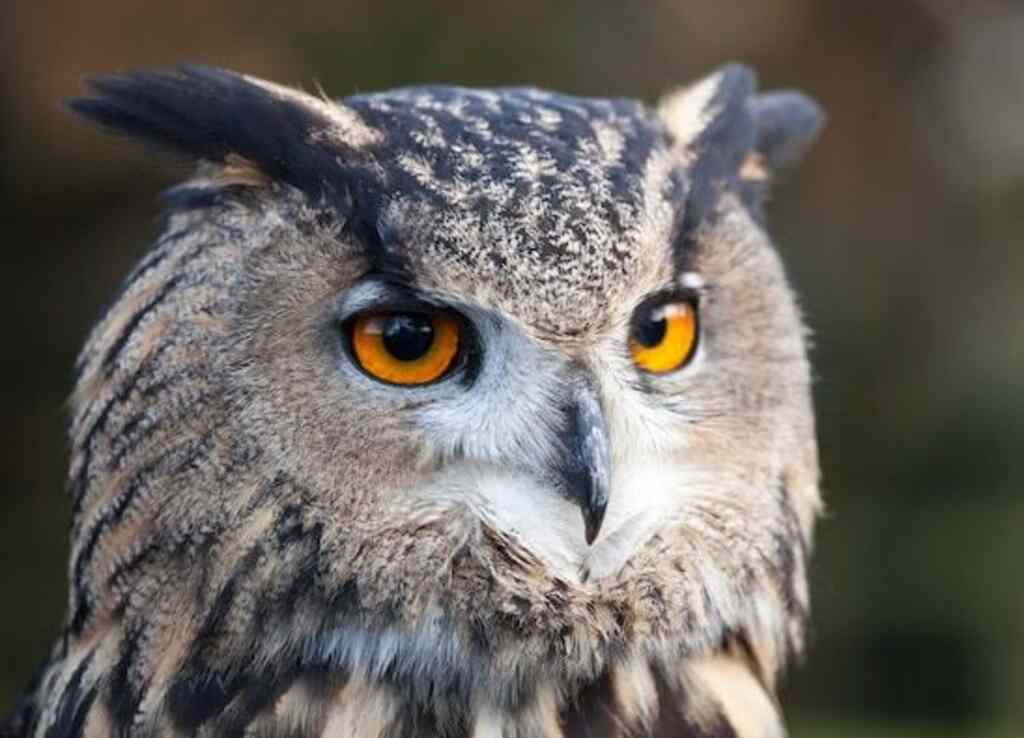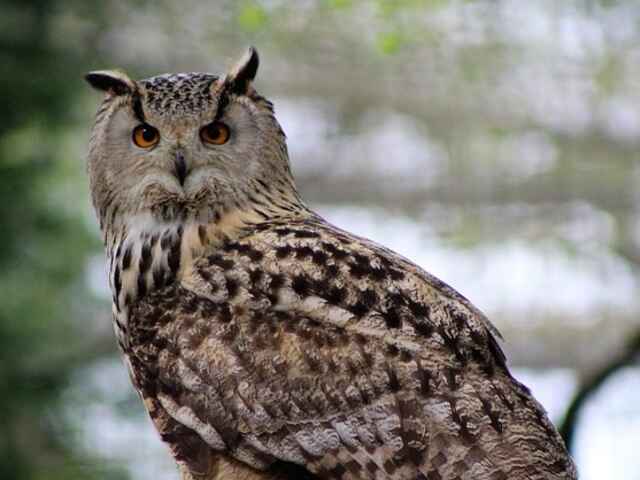Do owls blink? It’s a question that’s sure to pique your curiosity. Well, the short answer is yes, they do blink, but not quite like you and I. In fact, the way they blink is just one of the many fascinating things about these elusive creatures of the night.
So, let’s dive into the world of owls and uncover the secrets behind their unique blinking habits. Get ready for a hoot of a time!
Table of Contents
Definition of Owls
Owls are raptorial birds that belong to the order Strigiformes and are characterized by their upright stance, large heads with forward-facing eyes, hooked beaks, and sharp talons. There are around 230 species of owls in the world, with a wide range of habitats, from tropical rainforests to deserts.
Owls come in a range of sizes, from the petite elf owl that measures just 5 inches tall to the towering eagle owl that can grow up to 28 inches tall. The Strigidae family comprises around two-thirds of all owl species.
These owls have a round facial disk that helps them locate prey by focusing sound waves into their ears. The other third of owl species belongs to the family Tytonidae which includes barn owls that have a heart-shaped facial disk.
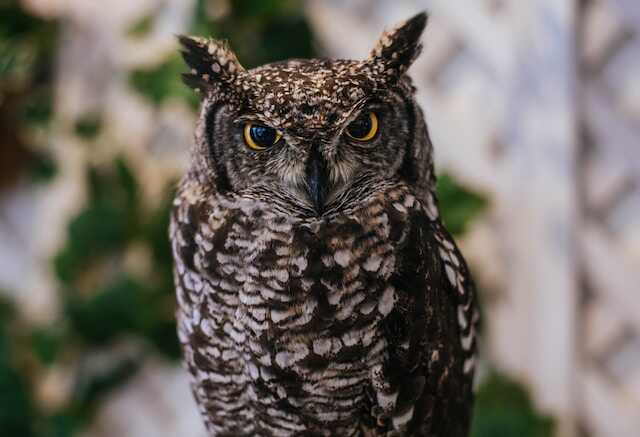
Importance of Blinking in Animals
Blinking is an essential function for most animals because it keeps their eyes moist and free from debris while protecting them from harm.
Blinking also helps distribute tear film over the cornea, which is important for clear vision. In humans, we blink about 15–20 times per minute on average, or more often if our eyes feel dry or irritated.
Dogs blink less frequently than humans because they have fewer nerve endings in their eyelids than humans do.
Some animals like fish or snakes don’t blink at all because they have a nictitating membrane that covers their eyes instead.
Overview of the Topic
In this article, we will explore whether or not owls blink. We will examine the anatomy of owl’s eyes and compare it with other birds to understand their unique adaptations for nocturnal hunting.
We will also delve into the research studies on owl’s blinking behavior and the role of blinking in owl communication and behavior.
We will discuss some interesting facts about owl blinking behavior that you might find surprising. So, let’s dive in and find out if owls blink or not!
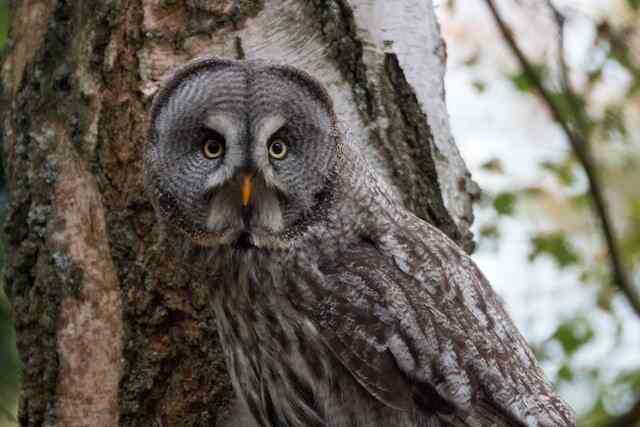
Do Owls Blink?
Explanation of Owl’s Eyesight
Owls are known for their keen sense of vision, which allows them to hunt in the dark. Their eyes are among the largest of all bird species, and they have a unique arrangement of rods and cones that enables them to see in very low light conditions.
Just like humans, owls have one fovea per eye, located in the temporal region. The foveae of owls are also unique in that they have a relatively higher density of rod photoreceptors, which is important for their excellent night vision. which enable them to focus on both distant and close objects simultaneously.
This allows them to maintain their depth perception while hunting in dimly lit environments.
One fascinating feature of owl’s eyesight is that they can rotate their heads up to 270 degrees in either direction without moving their bodies. This ability helps owls scan their environment for prey while remaining hidden from potential predators.
Comparison with Other Birds’ Blinking Habits
Blinking is a common reflex action among birds that helps keep their eyes moist and free from debris. However, because owls have evolved to hunt at night, they don’t need to blink as much as other birds do. In fact, research has shown that some owl species blink only once every hour or two.
This stands in stark contrast with other birds like pigeons or sparrows, who blink between three and four times per minute!
Additionally, unlike many bird species who close both eyelids simultaneously when blinking – called a complete blink – some owl species only blink one eye at a time.
Research Studies on Owl’s Blinking Behavior
Scientists have been interested in studying owl’s blinking behavior for several reasons. One reason is that it can provide insight into how these birds adapt to nocturnal environments where there is limited light available.
In one study published in the Journal of Comparative Physiology A: Neuroethology, Sensory, Neural and Behavioral Physiology researchers found that short-eared owls (Asio flammeus) blinked significantly less frequently when exposed to brighter light, suggesting that they may blink less in order to maintain their visual sensitivity during the night.
Another study published in the Journal of Experimental Biology found that owl’s nictitating membranes – a clear or translucent third eyelid – plays an essential role in protecting their eyes from dust and debris while hunting.
The researchers observed that the nictitating membrane is most active during blinking and helps clean and moisten the surface of the eye, which may explain why owls don’t need to blink as often as other birds.
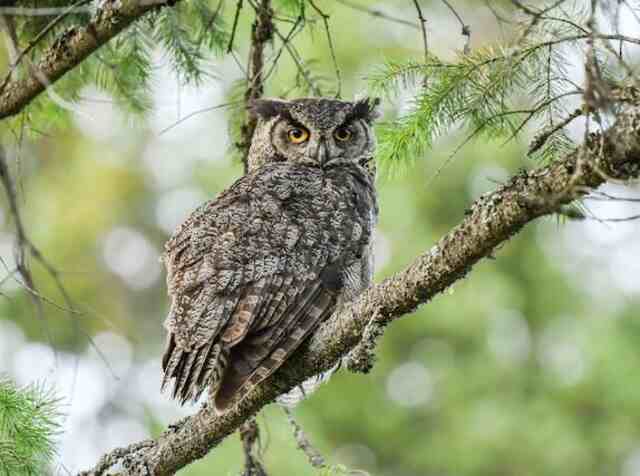
Why Owls Don’t Need to Blink As Much As Other Birds
Adaptations for Nocturnal Hunting
Owls are nocturnal predators, which means that they hunt during the night. This has led to the evolution of certain adaptations in their eyes that make them better suited for hunting in low light conditions. One of the most prominent adaptations is their large eyes, which allow more light to enter and provide a larger visual field.
Additionally, owls have binocular vision, which means that their eyes are positioned in such a way that they can focus on the same spot at the same time. This gives them better depth perception and helps them accurately judge distances between prey items.
Large Eyes
The eyes of an owl are proportionally larger than those of other birds relative to its head size. Owls’ eyes can occupy up to 70% of their skull’s volume.
The large size of an owl’s eye helps it gather more light in low-light conditions, making it easier for the bird to see its prey at night.
The retina of an owl’s eye has more rods than cones, which makes it more sensitive to changes in light levels, allowing owls higher visual sensitivity to movement in low light levels.
Binocular Vision
Like humans, owls have binocular vision — their eyes face forward with overlapping visual fields – this helps give them depth perception and allows them to accurately pinpoint prey while flying silently through forests at night.
In addition, owls’ binocular vision allows them to focus on a single point with both eyes simultaneously – giving them incredible accuracy when targeting prey items that may be moving quickly or erratically through foliage or darkness.
Eye Muscles That Prevent Dryness
Another adaptation for nocturnal hunting is found in an owl’s eye muscles. Most birds blink regularly to wet their eyes and remove dust or debris, but this would be a waste of time for an owl, as it would have to repeatedly adjust its focus in low-light conditions.
Instead, owls have muscles that prevent the eye from drying out, which is particularly important when they are flying at high speeds or catching prey items mid-flight.
Nictitating Membrane as an Alternative to Blinking
Owls do not blink frequently due to their adaptations for nocturnal hunting. Instead, they use a nictitating membrane (also called the third eyelid) to protect and lubricate their eyes without disrupting their vision.
The nictitating membrane is a thin layer of tissue that covers the eye from the side of the nose towards the ear when closed.
It serves as a transitional protective cover between blinking and open-eyed vision – it covers and protects the eye while still allowing some light through so that owls can continue to see while blinking.
Most birds also have this membrane, but in owls, it’s particularly well-developed and functions almost like goggles – protecting their eyes from wind or debris while capturing prey mid-flight.
Overall, these various adaptations make it possible for owls to see clearly in low-light conditions without frequent blinking.
The Role of Blinking in Owl Communication and Behavior
Significance of Eye Contact in Owls’ Social Interactions
Owls are not only solitary birds, but also have complex social lives. They use various non-vocal signals to communicate with other owls, including body posture, head movements, and eye contact. Eye contact is particularly important in owl communication, since it is used to signal dominance or submission.
When two owls meet, they may stare at each other for several minutes before engaging in aggressive behavior or mating rituals. Eye contact is so essential for owls that they have evolved unique adaptations to enhance their vision during nocturnal activities.
The size of an owl’s eyes allows it to capture even the slightest amount of light available at night, while binocular vision provides depth perception and allows them to focus on a specific object or prey.
Owls also have a specialized arrangement of muscles around their eyes that allow them to keep their eyes open for long periods without blinking.
Use of Blinking as a Threat Display or a Sign of Submission
While blinking is not as critical for owls as it is for diurnal birds, it still plays an essential role in their behavior. In some species, such as the Great Horned Owl, blinking can be used as a threat display towards intruders or predators.
The owl will puff up its feathers and blink repeatedly while staring down its opponent. On the other hand, some species use blinking as a sign of submission when confronted by more dominant individuals.
For instance, the Snowy Owl will close its eyes halfway and look away from the dominant bird when threatened. The context in which an owl blinks – how fast and how frequently – can also convey different messages within the species’ social interactions.
Relationship Between Blinking and Sleep Patterns
Owls are primarily nocturnal birds, and they are active at night while sleeping during the day. Because of this, their eyes must remain open for extended periods while hunting or monitoring their surroundings. Despite this, owls require sleep like any other animal.
To achieve this balance, owls have developed a unique adaptation called the nictitating membrane. This specialized eyelid moves horizontally across the eye to protect it from dust and debris without fully closing it.
Thus, owls can rest with one eye open while maintaining some level of vigilance for potential predators or prey. Furthermore, research has shown that blinking frequency in owls varies depending on their sleep patterns.
For instance, captive Burrowing Owls have been observed to blink more frequently when in REM (Rapid Eye Movement) sleep than when awake or in non-REM sleep. This suggests that blinking may be linked with brain activity during different stages of sleep.
Interesting Facts About Owl Blinking Behavior
Owl blinking behavior is fascinating and complex, with many intriguing details worth noting. For example, some species can blink each eye independently or even alternate between them to scan their surroundings better.
Additionally, owl species may vary in how quickly they blink – from 2-4 blinks per minute up to several hundred per minute during aggressive interactions. The role of blinking in owl communication and behavior is far more complex than initially thought.
Despite not being as crucial as for diurnal birds’ survival, owl blinking is still essential for social interactions and maintaining vigilance during nocturnal activities.
Understanding these aspects of owl behavior can help us better appreciate these magnificent creatures’ unique adaptations and behavior patterns.
Interesting Facts About Owl Blinking Behavior
A) How fast do owls blink?
Owls are well-known for their piercing gaze, but have you ever wondered how often they blink?
Despite the significant role that blinking plays in an animal’s eye health and comfort, owls actually blink much less frequently than most other birds, with some species only blinking a few times per day. In fact, some owl species may go several minutes without blinking at all!
When owls do blink, they tend to do so quickly. The average owl blink lasts approximately 300 milliseconds and occurs less than once per minute.
By contrast, humans blink around 15 times per minute on average. This infrequent blinking behavior is likely due to the adaptions that allow owls to remain alert while hunting.
B) Can owls blink with one eye at a time?
Unlike most birds, which can only close both eyes at once when they need to blink or rest, many owl species have the ability to close one eye at a time while keeping the other open.
This unique ability allows them to maintain constant vigilance while still giving their eyes the necessary moisture and protection from irritants.
While not all owl species can blink with just one eye at a time (this varies depending on the bird’s anatomy), those that can demonstrate this behavior typically use it as part of their hunting strategy.
For example, an owl might close its right eye while focusing intently on prey located directly in front of it and keep its left eye open to monitor surroundings for potential threats that could disrupt its hunt.
C) Do all owl species blink the same way?
While many aspects of owl biology are shared among different species (such as their nocturnal habits and highly effective hunting methods), there is actually a wide range of variation in how different types of owls blink.
Some species of owl blink upwards, while others blink downwards or laterally. The way in which an owl blinks can also provide important clues about its behavior and social structure.
For example, some species might employ a slow, exaggerated blink as a signal of submission or trust to other owls, while others might use rapid blinking as a sign of aggression or warning.
Overall, the low frequency and unique characteristics of owl blinking behavior make it an intriguing subject for further study into these fascinating predators.
FAQs: Do Owls Blink?
Do owls blink or close their eyes?
Yes, owls blink to keep their eyes moist and clean, just like humans. However, their blinking mechanism is different from ours, and they also have a nictitating membrane, which is a third eyelid that helps protect and lubricate their eyes.
What does it mean when owls blink at you?
Owls blinking at you does not necessarily have a specific meaning. It could simply be a natural behavior as they need to blink to keep their eyes moist and clean. However, if an owl blinks slowly and deliberately, it could be a sign of relaxation and comfort.
Do owls have to blink?
Yes, like all animals with eyes, owls have to blink to keep their eyes moist and clean, and to protect their vision. Owls have a specialized blinking mechanism and a third eyelid called the nictitating membrane that helps them see in different lighting conditions.
Do owls blink slowly?
Yes, owls do blink slowly, and it is part of their natural behavior. However, the rate at which they blink can vary depending on their level of alertness, activity, and comfort. Slow blinking can also indicate relaxation and comfort in owls.
How often do owls blink?
Owls blink less frequently than humans because their eyes are much larger and more efficient at keeping their eyes moist and clean. However, the frequency of their blinking can vary depending on their activity level and environment. On average, they may blink once or twice a minute.
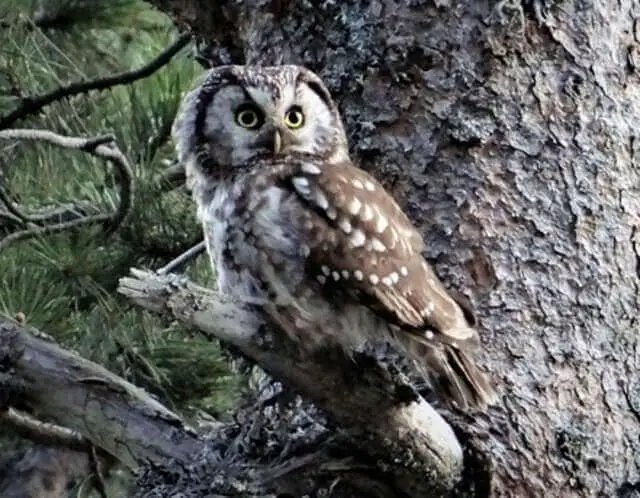
Conclusion
Owls have a unique blinking behavior that differs from other birds. While most birds blink frequently to keep their eyes lubricated and remove debris, owls have adapted to their nocturnal lifestyle by developing various mechanisms to prevent the need for excessive blinking.
With their large eyes, binocular vision, and special eye muscles that prevent dryness, owls can focus clearly on prey without needing to blink as often.
Furthermore, owl’s blinking behavior is not just for hunting purposes but also plays a crucial role in communication and social interactions. Eye contact is an essential part of an owl’s social hierarchy and dominance behavior.
Owls also use blinking as a sign of threat display or submission in various situations. Interestingly enough, owls’ blinking speed differs depending on their species.
For example, some larger owl species like the great horned owl blink slower than smaller ones like the screech owl. Despite this difference in speed, all owl species rely on their nictitating membrane as an alternative to traditional blinking.
While the research on owl’s blinking behavior is ongoing and fascinating, it is clear that these magnificent birds have adapted well to their unique environment and possess exceptional abilities that set them apart from other bird species.
Their distinctive characteristics make them a fascinating subject of study for researchers and bird enthusiasts alike.
Overall, studying owl’s blinking behavior provides insights into how animals adapt to different environments and develop specialized skills necessary for survival.
The more we learn about these incredible creatures, the better we can understand and appreciate the intricate connections within our natural world.

